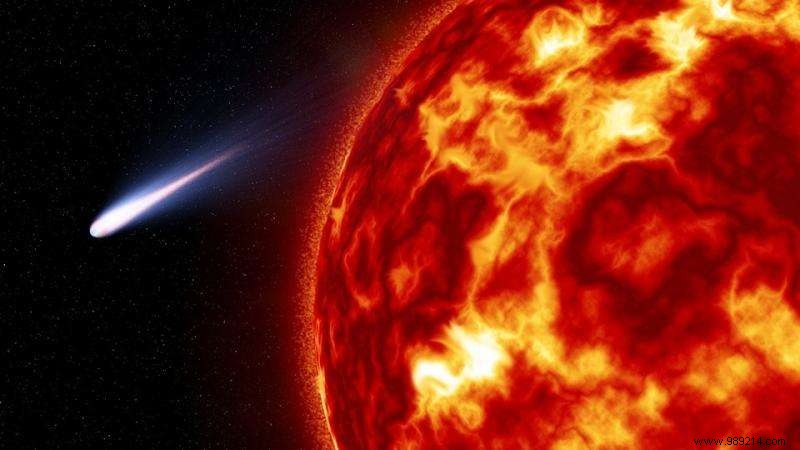Astronomers offer an alternative to the origin of the extinction of non-avian dinosaurs. A comet coming straight from the Oort Cloud — not an asteroid — may have been deflected off course by Jupiter's gravity, causing it to rub against the Sun. The powerful tidal forces of our star would then have torn fragments of this comet, and one of them would have finally collided with the Earth.
66 million years ago, a rock about ten kilometers in diameter, which sailed quietly in the asteroid belt, was diverted from its path to complete its road on our planet to the worst possible place. The explosion and the ensuing consequences led about 75% of living things to extinction . Dinosaurs were the first victims, later joined by sea creatures and plants.
At least, this is the most widely accepted hypothesis since the beginning of the 80s. This one is based on the analysis of the sedimentary layers located at the Cretaceous- Paleogene – found all over the world – which includes unusually high concentrations of iridium, a metal more commonly found in asteroids than on Earth.
Scholars have since identified the most likely impact site:the large crater of Chicxulub, Mexico, first discovered in the late 1970s. was reinforced in 2016, when a drilling project took cores from the tip ring of the crater, confirming that the rock had been subjected to immense pressure, the time of a few minutes.
That being said, a team of astronomers is now proposing an alternative to this origin . Their work is published in Scientific Reports .

Harvard undergraduate student Amir Siraj and astrophysicist Avi Loeb began looking into the impact rates of asteroids and comets on similar exoplanets to Earth a few years ago. This work also led them to focus on so-called long-period comets of our own solar system. These mainly come to us from the Oort cloud , located at the edge of the Solar System, about 100,000 astronomical units of the Sun. Or 100,000 times the Earth-Sun distance.
Their analyzes revealed several points. On the one hand, that Jupiter's gravitational field is strong enough to deflect many long-period comets from the Oort Cloud, bringing them very close to the Sun.
On the other hand, that a significant fraction of the Earth-crossing events of these comets were directly preceded by remarkably close encounters with the Sun.>
Thirdly, simulations also revealed that comets of ten to sixty kilometers in diameter could be torn into smaller fragments by the powerful tidal forces of our star.

The researchers also found that these events occur so often – and produce such a large number of fragments – that the likelihood of them resulting in an impact the size of Chicxulub's is greater than the impact rate related to asteroid populations.
The unusual composition of the Chicxulub impactor – the carbonaceous chondrite – again suggests that it probably came from the Oort cloud, where this material is much more abundant than in the main asteroid belt.
Finally, the authors also point out other impact craters of similar composition , including the Vredefort crater in South Africa – the result of an impact about two billion years ago – and the Zhamanshin crater in Kazakhstan, the result of an impact wiped over the last million years. However, these delays are in line with the calculations of Siraj and Loeb, suggesting that such objects should strike the Earth every 250,000 to 730,000 million years .
While the theory is attractive, it is based mainly on simulations. Also, additional work will obviously be necessary to confirm it. In particular, the researchers plan to look at the Vera Rubin observatory in Chile – which will see its first light next year – to confirm their hypothesis. "Hopefully we can test the theory by having more data on long-period comets, getting better statistics, and maybe seeing some evidence of some fragments concludes Avi Loeb.